The tight end position is one of the most difficult when it comes to transitioning from the college game to the NFL level. Not only do tight ends need to learn complex route schemes, but they are often asked to understand blocking in both the run and passing games. Considering all the variables, it’s extremely rare to see any rookie tight end break out.
[Editor’s note: Subscribe to PFF ELITE today to gain access to PFF’s Premium Stats and new Player Grades experience in addition to the 2020 NFL Draft Guide, 2020 Fantasy Rookie Scouting Report, PFF Greenline, all of PFF’s premium article content and more.]
Some tight ends — such as George Kittle, Mark Andrews, Travis Kelce and Zach Ertz — broke out in their second seasons, but others needed even more time before they became useful fantasy assets. Austin Hooper, Darren Waller and Tyler Higbee all broke out in their third or fourth seasons.
In fantasy football drafts, the elite tight ends come with high draft capital, and there are only so many of them. If you miss out at the beginning of your draft, it’s crucial that you snag one or two of these late-round targets who have shown the upside to suggest they can make the next leap.
In this series of articles, I’m looking at the breakout potential at the tight end position, focusing on players entering their second, third and fourth seasons. I'll take a look at their current situations to see if they have a clear path to targets and then analyze what they've done in the NFL to this point to determine whether they have shown the upside to break out in 2020.
The Atlanta Falcons traded for Hayden Hurst this offseason after deciding not to bring back starting tight end Austin Hooper. Hurst was used sparingly during his first two years with the Baltimore Ravens, playing fewer snaps and running fewer routes than tight ends Mark Andrews and Nick Boyle. As the expected No. 1 tight end for the Falcons, Hurst has the chance to be an every-down player in an offense that projects to throw much more often than the Ravens.
Exclusive content for premium subscribers

WANT TO KEEP READING?
Dominate Fantasy Football & Betting with AI-Powered Data & Tools Trusted By All 32 Teams
Already have a subscription? Log in



 © 2025 PFF - all rights reserved.
© 2025 PFF - all rights reserved.